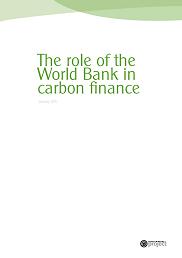The role of the World Bank in carbon markets
-----------------
This paper outlines the World Bank’s involvement in the carbon market and reviews concerns about its impacts on greenhouse gas emission reductions and development. First, it introduces the role and aims of the Bank’s Carbon Finance Unit and the various funds and facilities that it manages. The Bank has worked to shape the carbon market by reducing risk for other investors, setting social and environmental standards, and developing new types of projects. It is now focusing on promoting national programmes', reducing emissions from deforestation; and large-scale, long-term carbon finance.
The paper then summarises the concerns that have emerged from official evaluations and scrutiny by civil society groups regarding the effectiveness of Bank carbon finance in reducing emissions and generating development benefits, adding new evidence where available.
Concerns include:
- Failure to produce expected emissions reductions;
- Finance supporting heavily polluting industries, including coal power, and as a result delaying the transition to a low-carbon economy;
- Lack of additionality in terms of finance and emission reductions;
- Conflicts between the Bank’s carbon-intensive portfolio and its role in carbon finance;
- Very limited finance going to smaller, poorer countries, despite these being an express priority for the Bank;
- Evidence that purported development benefits are not integral to Bank carbon finance, despite the Bank being a development institution;
- Negative social impacts associated with Bank carbon projects and programmes, including conflicts over resource rights and sharing of benefits;
- Major shortcomings on transparency, engagement and accountability, particularly in monitoring whether commitments to community benefits are fulfilled;
- Limited effectiveness in achieving the official Bank goal of transferring and diffusing technologies to developing countries and poor communities.
|
---------------


